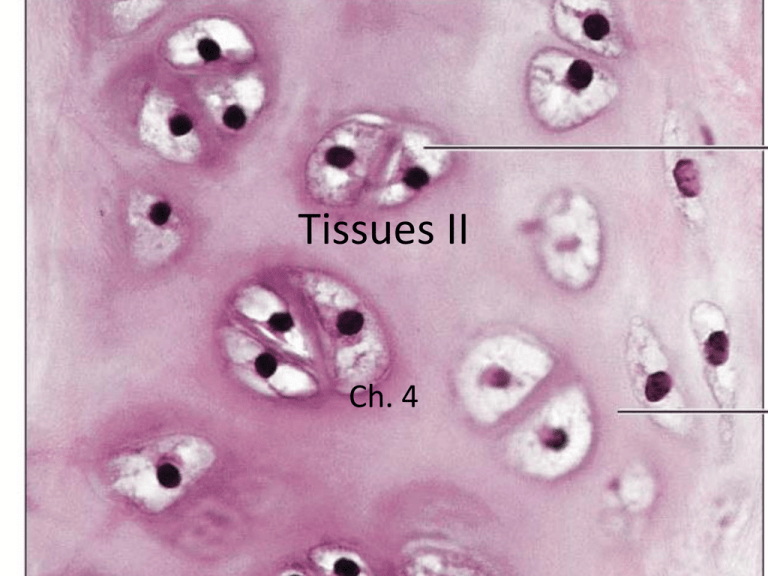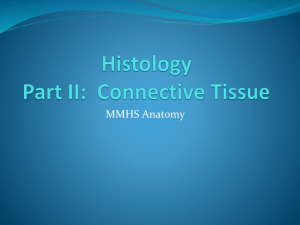Connective Tissue
advertisement

Tissues II Ch. 4 Connective Tissue Matrix • Extracellular substances in which connective tissue cells are imbedded. – Support, strength, elasticity • Hyaluronic acid: lubricates joints, maintains shape (eyeball) • Chondroitin sulfate: support, adhesion of cartilage, bone, heart valves, cornea, umbilical cord Matrix • Collagen fibers: cartilage, tendons, ligaments (inelastic) • Reticular fibers: support fat, nerves, muscle, and blood vessels (collagen, glycoproteins) • Elastic fibers: elastin protein, skin and blood vessels Connective Tissue (CT) • 4 classes of connective tissue 1. 2. 3. 4. Connective Tissue Proper Cartilage Bone Blood Most abundant and widely distributed of the 4 tissue types in body, amount in particular organs varies Functions of Connective Tissue 1. Binding and support Ex. bone, connective tissue proper 2. Protection Ex. bone, connective tissue proper 3. Insulation Ex. connective tissue proper 4. Transportation Ex. blood 5. Stores energy Ex. Connective tissue proper Characteristics of Connective Tissue • All connective tissues arise from mesenchyme • Cells widely scattered within extracellular matrix (except adipose tissue) • Most of CT is non-living extracellular matrix • Most highly vascularized (except cartilage) Extracellular Matrix of Connective Tissue • Consists of A. Ground substance material in space around cells; largely consists of proteins & fluid B. Fibers 1. 2. 3. Collagen fibers - Made of collagen (a fibrous protein), most abundant/strongest Elastic fibers - Made of elastin (a rubber-like protein) thin, branching Reticular fibers - Made of collagen, thin branching Connective Tissue Cell Types 1. Macrophages – “eat” foreign molecules 1. Fibroblast – secrete fibers until they mature into fibrocytes 1. Leukocytes (WBC)– immune response 4. Mast cells – inflammatory response 5. Adipocyte – fat cell • Cells maturity has different names – blast means forming => these are immature, actively mitotic cells that secrete ground substance and fibers for that particular matrix – cyte indicates a blast cell that has become a mature, less active cell Macrophages - phagocytize and break-down foreign materials (macrophages are mature) Leukocytes or white blood cells - involved in immune response Mast cells- involved in inflammatory response Adipocyte - fat cells- store nutrients Connective Tissue (CT) • 4 classes of connective tissue 1. Connective Tissue Proper 2. Cartilage 3. Bone 4. Blood 1. Connective Tissue (CT) Proper A. Loose CT 1. Areolar Loose CT 2. Adipose Loose CT 3. Reticular Loose CT B. Dense CT 1. Dense regular CT 2. Dense irregular CT 3. Dense elastic CT A. Loose Connective Tissue Other Function- soak up fluid that would cause edema, underlies most epithelial tissue, abundant. edema LCT: Adipose • Adipocytes - store fat, nucleus displaced to the side • SUPPORTS AND PROTECTS ORGANS, STORES FAT, INSULATES • White fat = stores nutrients • Brown fat = lost of mitochondria to make heat instead of ATP – Babies STROMA (“MATTRESS”)- internal framework support reticular fibroblasts and others (white blood cells, mast cells, macrophages) B. Dense (Fibrous) Connective Tissue DCT: Dense Regular • Little ground substance, mainly thick wavy collagen fibers running in parallel - very strong and provides resistance to pulling (in the direction the fibers run) – few elastic fibers • Fibroblasts are the cells - constantly making collagen fibers • FORM TENDONS, LIGAMENTS, AND APONEUROSES Dense Regular Connective Tissue Makes up: a. Ligaments - attach bone to bone, more elastin a. Tendons - attach muscle to bone, cord-like a. Aponeuroses – sheet-like; attach muscle to muscle or bone a. Fascia - “plastic wrap” for muscles fibroblasts between elastic fibers, Allows tissue to recoil after stretching -walls of large arteries, walls of bronchial tubes and lungs, ligaments attaching vertebra together 2. Cartilage A. Characteristics 1. Matrix – gel-like (up to 80% water) 2. Avascular • • • At what developmental stage would the chondroblasts stop secreting matrix? Nutrients from blood vessels in perichondrium Dense irregular CT membrane 3. Cells called chondroblasts secrete matrix (immature), mature into chondrocytes (in lacunae) 4. Can withstand tension and compression 2. Cartilage B. Types 1. Hyaline cartilage 2. Elastic cartilage 3. Fibrocartilage SHOCK ABSORBER LC2 3. Bone A. Characteristics 1. Matrix • Calcium salts • Collagen fibers 2. Vascularized 1. Cells called osteoblastssecrete matrix (immature), mature into osteocytes (1 per lacuna) 3. Bone B. Types 1. Compact Bone Osteon (Haversion System) – fundamental unit - Lamella – (bone calcium salt ring) - Lacuna – space containing the osteocyte - Central (Haversion) Canalblood, lymph, nerves - Volkmann’s Canal – transverse canals - Canaliculi – microscopic canals between lacunae 2. Spongy Bone – Trabeculae (thin lattice plates) 4. Blood A. Characteristics 1. Matrix – plasma (90% water) 2. Cell types – i. Red blood cells (erythrocytes) – no nucleus, O2 and CO2 transport • ii. White blood cells (leukocytes) - nucleated, 5 types 1. 2. 3. 4. 5. iii. If there is no nucleus what cellular process is not functional? Neutrophils Lymphocytes Monocytes Eosinophils Basophils Platelets (thrombocytes) – blood clotting Muscle Tissue -Contractile Tissue 3 Types: 1. Skeletal 2. Cardiac 3. Smooth Thin and thick myofilaments give banded look, many mitochondria Sarcolemma – plasma membrane Sarcoplasm - cytoplasm Involuntary, specialized gap junctions called intercalated discs INVOLUNTARY CONTROL Nervous Tissue Nervous Tissue • Cell types: 1. Nerve cell = neuron generate and transmit electrical impulses a. Dendrites – receives and responds b. Axon – transmits impulse 2. Supporting cells: do not conduct impulses Stimulus LC3 Membranes • Made up of different tissues put together to form a specialized function Membranes • 4 types – Cutaneous – skin • IS AN ORGAN SYSTEM! • Outer layer is stratified squamous epithelium that is keratinized (called epidermis) and underlying dermis (dense irregular connective tissue) Membranes • 4 types 1. Cutaneous - skin 2. Serous - lining ventral body cavity and organs 1. simple squamous epithelium (called mesothelium) and underlying layer of areolar loose connective tissue • 4 types Membranes 1. Cutaneous - skin 2. Serous - lining ventral body cavity and organs 3. Mucous - line body cavities open to exterior 1. stratified squamous or simple columnar epithelia and underlying layer of areolar loose connective tissue Membranes • 4 types 1. 2. 3. 4. Cutaneous - skin Serous - lining ventral body cavity and organs Mucous - line body cavities open to exterior Synovial - line joint cavities Loose areolar connective tissue and adipose Membranes 1. Cutaneous – ET and CT 1. Serous – ET and CT 1. Mucous – ET and CT 1. Synovial – CT and CT LC4





